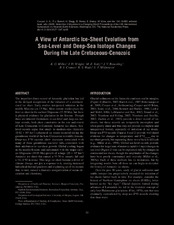| dc.identifier.citation | Miller, K.G., Wright, J.D., Katz, M.E., Browning, J.V., Cramer, B.S., Wade, B.S., Misintseva, S.F. 2008. A view of Antarctic ice-sheet evolution from sea-level and deep-sea isotope changes during the Late Cretaceous-Cenozoic. In: Cooper, A.K., Barrett, P.J., Stagg, H., Storey, B., Stump, E., Wise, W. and the 10th ISAES editorial team (Eds.). Antarctica: A keystone in a changing world. Proceedings of the International Symposium on Antarctic Earth Sciences. National Academy of Sciences Press, Washington, D.C, pp. 55-70. doi:10.3133/of2007-1047.kp06 | en |
| dc.description.abstract | The imperfect direct record of Antarctic glaciation has led to the delayed recognition of the initiation of a continent-sized ice sheet. Early studies interpreted initiation in the middle Miocene (ca 15 Ma). Most current studies place the first ice sheet in the earliest Oligocene (33.55 Ma), but there is physical evidence for glaciation in the Eocene. Though there are inherent limitations in sea-level and deep-sea isotope records, both place constraints on the size and extent of Late Cretaceous to Cenozoic Antarctic ice sheets. Sea-level records argue that small- to medium-size (typically 10-12 × 106 km3) ephemeral ice sheets occurred during the greenhouse world of the Late Cretaceous to middle Eocene. Deep-sea δ18O records show increases associated with many of these greenhouse sea-level falls, consistent with their attribution to ice-sheet growth. Global cooling began in the middle Eocene and culminated with the major earliest Oligocene (33.55 Ma) growth of a large (25 × 106 km3) Antarctic ice sheet that caused a 55-70 m eustatic fall and a 1‰ δ18O increase. This large ice sheet became a driver of climate change, not just a response to it, causing increased latitudinal thermal gradients and a spinning up of the oceans that, in turn, caused a dramatic reorganization of ocean circulation and chemistry. | en |


